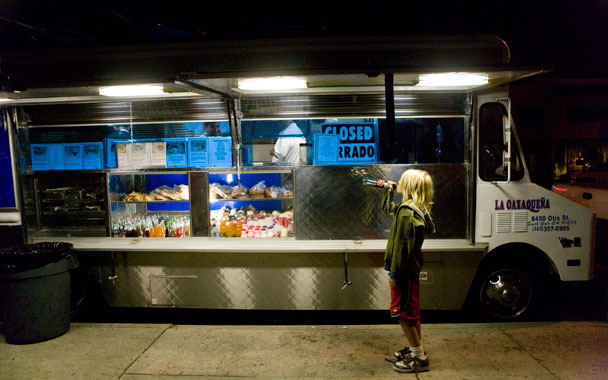The other evening, my husband and I drove to a taco truck parked on the corner of 3rd and Normandie, just on the edge of Koreatown. For roughly $30 we bought 15 spicy chicken-and-red-chile tacos and 15 tacos al pastor plus a side of grilled whole jalapeños to take to a friend’s late-night potluck birthday party. Until our order came up we sat on plastic folding chairs on the sidewalk, along with four men hunched over plates of food, and we all watched the movie Alpha Dog dubbed in Spanish on a tiny television rigged inside the truck. My husband and I had never been to this particular truck before, but even without the business’s name, a friend of ours was able to direct us there by saying “3rd and Normandie.” And yet, if this friend had recommended a truck he’d discovered in, say, East Los Angeles instead of in central L.A., we’d probably never bother trying to find it. In April, Los Angeles County passed a new law that requires mobile food vendors in roughly 65 percent of the county to move their locations every 60 minutes—otherwise they can face a fine of up to $1,000, misdemeanor charges, and/or 6 months in jail. By targeting the very aspect of these businesses that helps them establish word-of-mouth recognition—a reliable location, never changing—the law effectively kills their chances of succeeding.
What is now known as the “anti-taco-truck” ordinance became front-page news all over the country and inspired Saveourtacotrucks.org, a website created by two local teachers that has collected nearly 4,500 signatures in an online protest petition. Yet so far, the ordinance has only been enforced once: Alejandro Valdovino, owner of a truck called La Flor de Sahuayo, received a misdemeanor citation while parked in front of his own East Los Angeles restaurant. (“Whose business am I stealing? My own?” Valdovino asked an Associated Press reporter.)
Among the theories offered as to why only one person has been charged: that in a crime-filled city illegal parking isn’t high on the list of the L.A. County sheriff’s department; that the L.A. County Board of Supervisors’ Gloria Molina, a native Angeleno and Hispanic-rights advocate who pushed the ordinance through at the behest of anti-taco-truck restaurant and homeowners associations, is reconsidering the wisdom of her decision. A few days ago, when I called Molina’s senior press deputy, Roxane Marquez, she told me that the lack of enforcement is because officers had been instructed to educate, not ticket, until July 1—today. “Right now, we are in what we call ‘a public information awareness mode,’” Marquez told me, outlining a plan in which sheriff’s deputies first passed out flyers to truck owners so they could bone up on the changes in the law. Why July 1? Because it’s the same day that L.A.’s hands-free cell phone law starts being enforced. “We just thought it was a good date to have in everybody’s mind,” said Marquez, as if talking on a cell while speeding down the freeway and losing the ability to attract customers to your small business were somehow connected.
So today the hammer supposedly comes down. But what have these past few months been like for those who make their living selling tacos, gorditas, and tortas on the go? As he stood in a parking lot in Maywood, CA, surrounded by dozens of taco trucks, Alfredo Ortega Hernandez of El Primo Tacos broke it down: Setting up takes 20 to 30 minutes. That’s finding a parking spot; starting up the grill; opening the side panels on the truck; putting out the sliced cucumbers, shredded cilantro, chopped chile, and vats of fiery salsas; then arranging folding chairs for the diners. Shutting down—meaning picking up, packing up, turning off, and hitting the road—takes a quarter of an hour. That leaves roughly fifteen minutes or so to actually sell tacos, enchiladas, tortas and gorditas. In between, Hernandez says, he and his crew have been experimenting with ways to alert patrons to the truck’s next location. “Our customers can’t find us,” said Hernandez, while shoveling crushed ice from a huge wheelbarrow into the truck’s beverage bin. “Business is down 50 percent,” he says, with a shrug. “They just go somewhere else.”



 Pinterest
Pinterest


